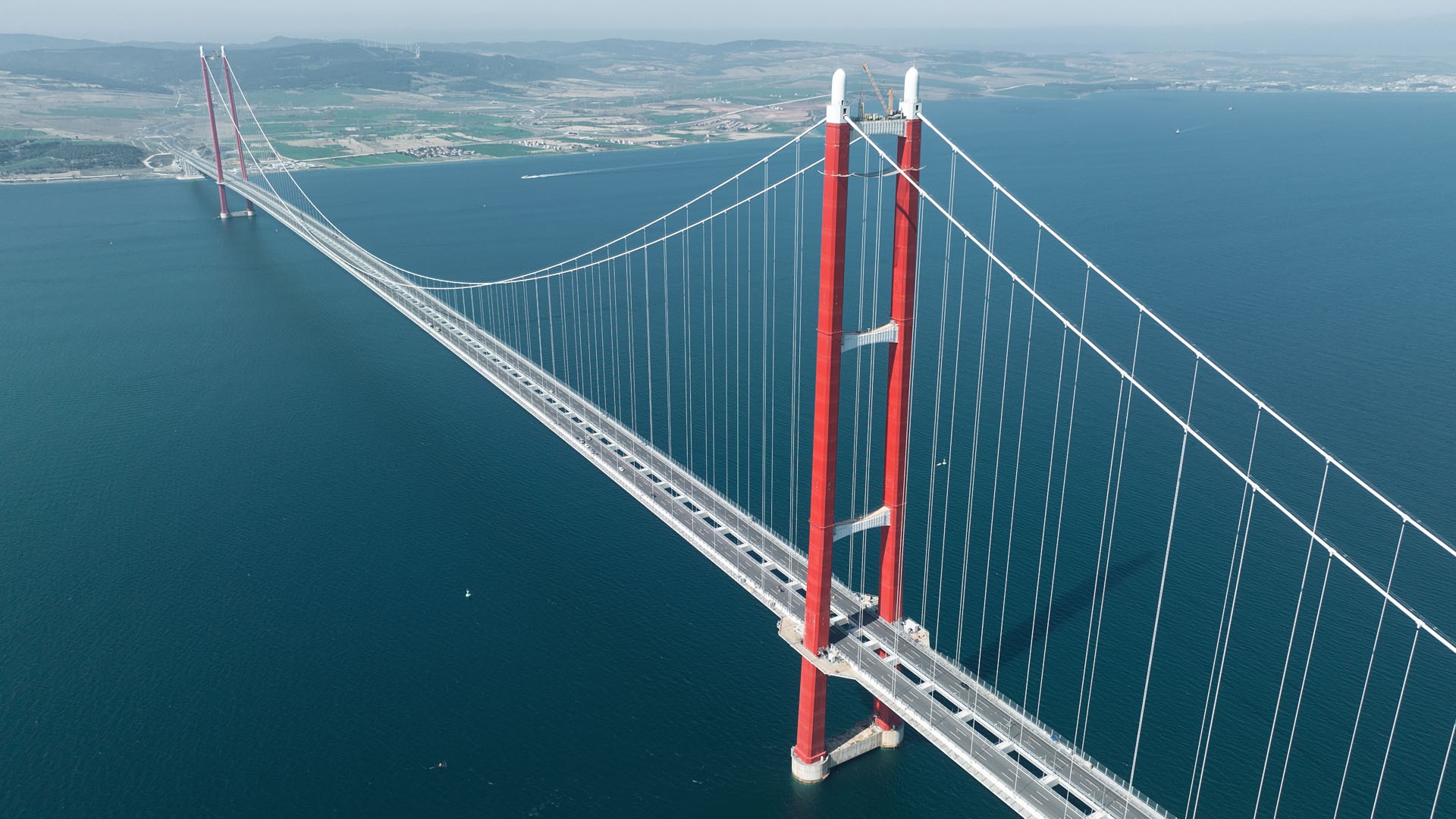
1915Canakkale Bridge in Turkey - dismantling of the HC-L cranes
The 1915Çanakkale Bridge is an impressive structure, stretching almost five kilometres across the Dardanelles. It connects the cities of Gelibolu on the European side and Lapseki on the Asian side of Turkey. Featuring a middle span of 2,023 metres, it is the longest suspension bridge in the world. The six-lane bridge, which opened in March 2022, is an important connecting route for motorists and an alternative to the congested one going through Istanbul. Construction took five years altogether.
Two Liebherr 357 HC-L luffing jib cranes on 355 IC tower systems played an instrumental part in this project. As a solution provider, we delivered a comprehensive package, covering everything from crane planning to assembly, maintenance and disassembly, right through to supporting consultancy services. The customer, a joint venture made up of two Korean (DL E&C, SK Ecoplant) and two Turkish (Limak, Yapı Merkezi) companies (DLSY for short), was on the lookout for a custom-fit solution. The reason for this being that Çanakkale is one of Turkey’s largest earthquake hotspots and also a region dominated by strong winds.
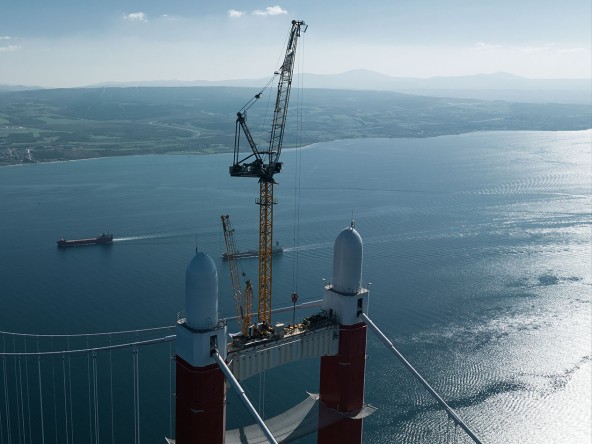
How are those HC-L cranes going to get back down? That’s the question that immediately springs to mind when you look at this photo of the 1915 Çanakkale Bridge in Turkey. The cranes have now been dismantled – a spectacular disassembly that pushed humans and machines to their limits and beyond.
The first 357 HC-L lowered its top tower sections from its position on one of the 1915Çanakkale Bridge’s two pylons and then a 200 DR 5/10 derrick crane set to work. The service technicians started off by suspending the HC-L’s jib head. Working with our Tower Crane Solutions team, they had meticulously planned this disassembly with the customer for weeks. Two modern luffing jib cranes – one on each pylon – needed to be brought back down to the ground.
The derrick was specially mounted on a podium so it was able to reach the HC-L’s components. The wind was a concern. “Every disassembly is different,” explains service technician Frank Nebe, who has managed this disassembly. He has experienced various disassemblies around the world, including ones in Seattle, Dubai and London. “Our biggest challenge in Turkey was the wind,” he says. Fierce gusts regularly whistle through the Dardanelles, a strait in the Mediterranean Sea between the Aegean and the Sea of Marmara.
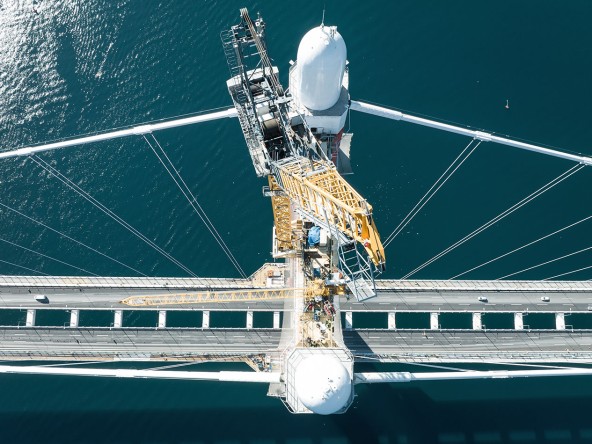
As was the case with the bridge’s construction, the disassembly process was unique. “A straight forward standard solution didn’t exist. Working together with the customer, we developed a tailor-made concept that accommodated limited space, logistical challenges and geographical conditions. Our years of experience helped us a great deal,” says Robert Strohmaier from the Tower Crane Solutions project department. Such a dismantling of the HC-L cranes was anything but ordinary and every step had to be carefully checked so that problems wouldn’t arise later.
The concept worked as follows: First the derrick cranes were preassembled on the ground and then lifted onto the pylons by the HC-L cranes. The derrick cranes subsequently took over and dismantled the HC-L cranes with all their components. Trucks transported the crane parts away. Afterwards, the derrick cranes largely dismantled themselves; only their substructure and tower were lowered from the pylons with the help of another small auxiliary crane. Our derrick crane is actually so compact that it can be brought down to the ground via a lift. But this dismantling required a special solution as access to the lift was too narrow.
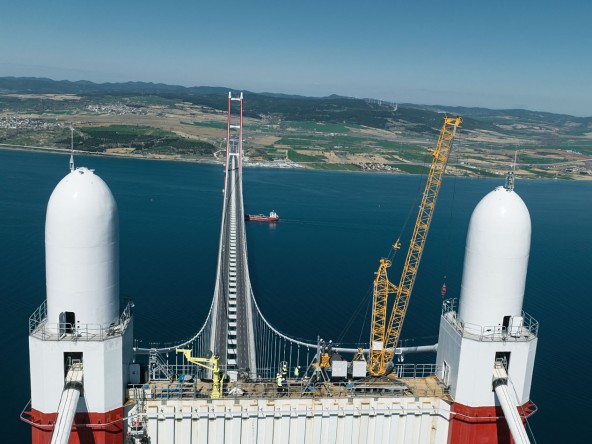
So, was it all a success? “Everything worked smoothly, just as we planned,” concludes Frank Nebe, the cranes having been dismantled in three phases between February and April of this year. Sound advance planning paved the way for this, as did the commitment of each individual on site. A total of 13 experienced service technicians from six countries and four Liebherr companies worked together brilliantly.
This team spirit got them through the challenges they faced. Temperatures ranged from -5 to +20 °C and the pylons only offered around 100 square metres of space. “We have more space than that when we’re dismantling on high rises. Things were pretty tight, especially with all the tools and materials involved,” Frank Nebe explains. “Sometimes winds reached 40 kilometres per hour. That caused the pylons to sway a lot.”
“It was hard work, but we did it! I’m proud of what we achieved,” says service technician Zeeshan Ahmed from Liebherr in Saudi Arabia. When asked about his personal highlights, he replies, “What impressed me most was the constructive teamwork, the great organisation and the extensive experience of my colleagues.”
The success of this project is of course down to the exceptional teamwork and amazing effort of everyone involved over the three-and-a-half-year time frame. Even the smallest contributions made a big difference and performance was strong from start to finish
“The success of this project is of course down to the exceptional teamwork and amazing effort of everyone involved over the three-and-a-half-year time frame. Even the smallest contributions made a big difference and performance was strong from start to finish,” says Bugra Secgin, Head of Division Tower Cranes at Liebherr in Turkey. “I had mixed feelings when the last part of the derrick came down from the pylon: I was really relieved, but a little sad too. I have some great memories and will always remember this project with a smile.”
Despite Frank Nebe's years of experience, he still found the dismantling spectacular, “It was impressive to stand up there; on a structure that I’d only known from pictures and on paper until that point.” He adds that the team was second to none and that their enthusiasm was unwavering throughout, “The project was absolutely one of a kind and I’ve never done anything like it before in my life either.” The successful disassembly was the icing on the cake for an impressive infrastructure project that brings people closer together.
By clicking on “ACCEPT”, you consent to the data transmission to Google for this video pursuant to Art. 6 para. 1 point a GDPR. If you do not want to consent to each YouTube video individually in the future and want to be able to load them without this blocker, you can also select “Always accept YouTube videos” and thus also consent to the respectively associated data transmissions to Google for all other YouTube videos that you will access on our website in the future.
You can withdraw given consents at any time with effect for the future and thus prevent the further transmission of your data by deselecting the respective service under “Miscellaneous services (optional)” in the settings (later also accessible via the “Privacy Settings” in the footer of our website).
For further information, please refer to our Data Protection Declaration and the Google Privacy Policy.*Google Ireland Limited, Gordon House, Barrow Street, Dublin 4, Ireland; parent company: Google LLC, 1600 Amphitheatre Parkway, Mountain View, CA 94043, USA** Note: The data transfer to the USA associated with the data transmission to Google takes place on the basis of the European Commission’s adequacy decision of 10 July 2023 (EU-U.S. Data Privacy Framework).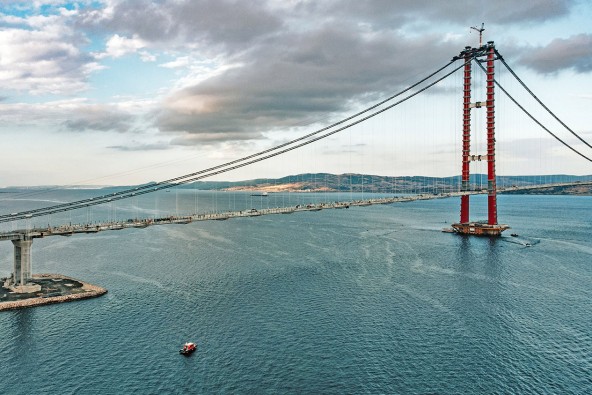
Bridge between continents
For a long time, the two tower cranes of type 357 HC-L marked the highest point of the bridge construction project "1915Canakkale Bridge" at 318 meters. The longest suspension bridge in the world, which connects the European side with the Asian side of Turkey, was on the one hand a very special assignment for our service technician Engin Dalman, but on the other hand as routine as ever.

